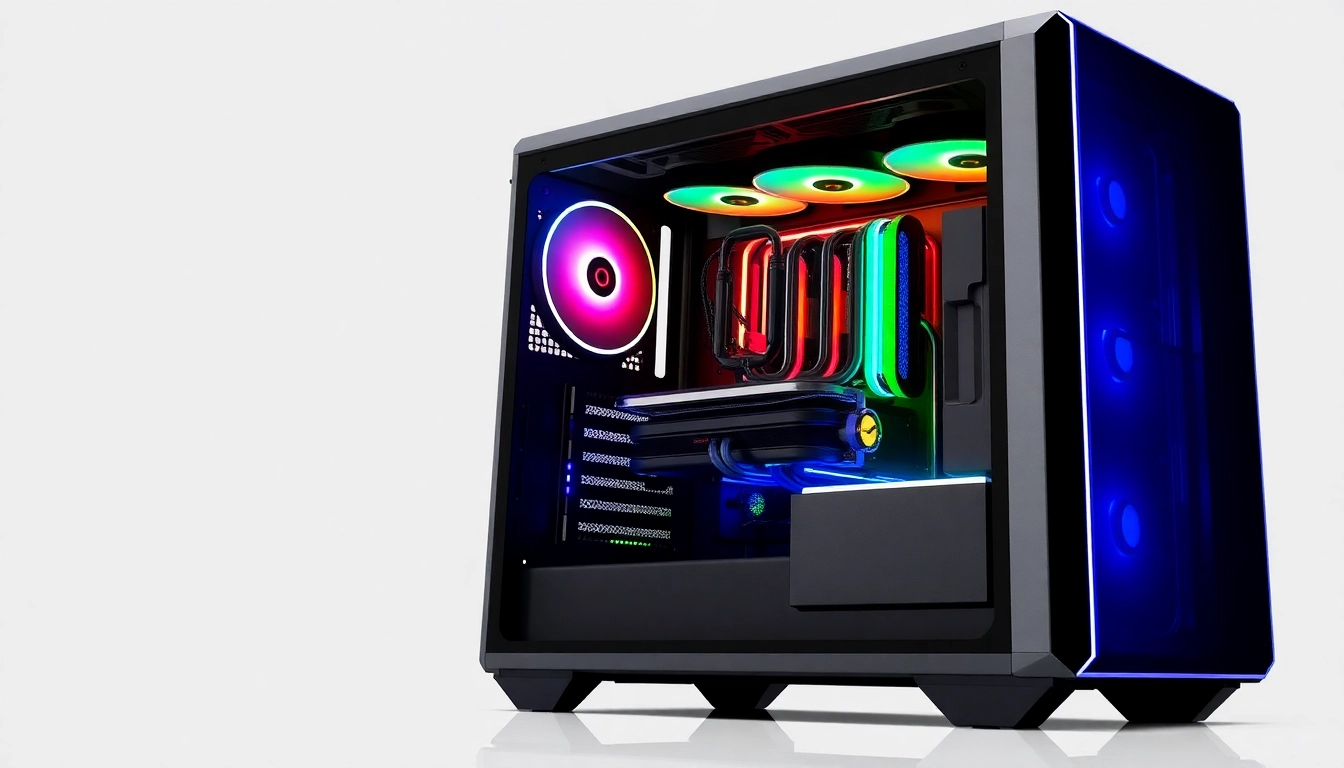Understanding Gaming PC Cases
What is a Gaming PC Case?
A gaming PC case is an enclosure that houses the various components of a personal computer designed specifically for gaming. It serves not only as a protective barrier for the hardware but also plays a pivotal role in thermal management, aesthetics, and functionality. The right gaming pc case can be the difference between a smooth gaming experience and one riddled with performance issues caused by overheating or poor airflow.
In the realm of gaming, these cases are often designed with additional features that cater specifically to the needs of gamers, such as RGB lighting, tempered glass panels for visibility, sound dampening features, and options for extensive cable management. Understanding the different components that make up a gaming PC case is essential for any aspiring builder or upgrader looking to improve their setup.
Importance of Cooling in Gaming PC Cases
One of the primary functions of a gaming PC case is to manage the cooling of its internal components. Gaming hardware tends to generate significant amounts of heat, especially during intensive tasks such as high-resolution gaming or running multiple applications simultaneously. Effective cooling solutions within a gaming case can significantly enhance the performance and lifespan of the components.
Most gaming PC cases are designed with various cooling options, including air and liquid cooling setups. Cases with high airflow designs typically feature larger fans and optimized internal layouts to enhance airflow, while others may support AIO (All-In-One) liquid cooling solutions, which can further reduce temperatures in high-performance builds. Some features to look for in terms of cooling include:
- Fan Placement: Locations for multiple fans that can be adapted based on the user’s cooling needs.
- Radiator Support: The ability to install radiators for liquid cooling solutions.
- Ventilation: Mesh panels or vents that improve airflow and reduce heat build-up.
Case Size and Form Factors Explained
When selecting a gaming PC case, it’s vital to understand the various sizes and form factors available. The most common form factors include ATX, Micro ATX, Mini ITX, and Full Tower cases. Each one accommodates different types of hardware and has its unique advantages and disadvantages.
For instance, ATX cases are popular due to their balance between size and expandability, making them suitable for a variety of builds. Micro ATX and Mini ITX cases are perfect for compact builds but may limit the upgrade options. Full Tower cases offer extensive space and compatibility for larger components, making them ideal for enthusiasts looking to push their systems to the limit. Users must assess their specific needs and future upgrade plans before choosing a case to ensure their investment is met.
Features to Look for in a Gaming PC Case
Airflow and Cooling Options
As mentioned earlier, airflow is critical. A case with good airflow can mean the difference between stable performance and overheating issues. Look for designs that offer ample fan and radiator space, such as those that can accommodate 200mm fans, along with options for top, bottom, and front ventilation.
Specific features to consider include:
- Removable Dust Filters: Essential for keeping the internals clean and reducing maintenance time.
- Fan Speed Control: Options to manage the noise levels and cooling performance based on specific use cases.
- Temperatures Monitoring: Some cases come equipped with temperature sensors that help users monitor the performance in real-time.
Compatibility with Components
Not all cases are created equal, and compatibility is paramount when selecting a gaming PC case. Users should know the dimensions of their graphics card, motherboard, power supply, and any other components they plan to include. This information helps ensure that each component will fit comfortably within the chosen case.
Consider the following when checking compatibility:
- GPU Length: Verify the maximum length supported to avoid clearance issues.
- CPU Cooler Height: Cases often list a maximum CPU cooler height, which is vital for larger models.
- PSU Length: Like the GPU, the compatibility of the power supply dimensions with your case is essential for clean cable management and adequate airflow.
Aesthetic Appeal and Customization
For many gamers, aesthetics and customization options play a crucial role in choosing a gaming PC case. RGB lighting, tempered glass side panels, and unique shapes can make a gaming rig look stunning while allowing for personalization. Gamers are increasingly looking for ways to express themselves through their setups. Features like programmable RGB lighting, modular panels, and interchangeable components allow for this level of creativity.
The aesthetic appeal goes hand-in-hand with functional design; it’s essential to choose a case that not only looks good but also performs well. A case that allows for good airflow while offering an eye-catching design can provide an optimal balance between form and function.
Comparing Popular Gaming PC Cases
Mid-Tower vs Full-Tower Cases
Choosing between a mid-tower and full-tower case often boils down to personal preferences and specific needs. Mid-tower cases are well-suited for most gaming setups, offering ample room for most components, while full-tower cases provide maximum space for high-performance builds and extensive cooling options.
Mid-tower cases are generally more compact, making them suitable for users with desk space limitations or those who prefer a less bulky setup. On the other hand, full-tower cases appeal to enthusiasts aiming for future-proof builds that might include multiple graphics cards or custom liquid cooling setups. Users must evaluate their current needs and future upgrade plans to make the most informed decision.
Best Brands and Their Offerings
Several brands are renowned for producing high-quality gaming PC cases. Some of these include:
- Corsair: Known for its well-designed cases that often include RGB lighting and excellent build quality.
- NZXT: Offers cases with a focus on aesthetics and cable management, often equipped with features meant for novice builders.
- Thermaltake: Favors bold designs and flexibility, making it a top choice for gamers and modders alike.
- Lian Li: Specializes in aluminum cases that are both lightweight and durable, often appealing to custom builders looking for elegance.
All these brands put an emphasis on quality and user satisfaction, backing their products with warranties and robust customer support.
Customer Reviews and Ratings
When researching gaming PC cases, one of the best sources for unbiased information is customer reviews. Online platforms allow users to share their experiences with specific cases, offering insights into how well a case performs under real-world conditions. Topics discussed in reviews often include ease of assembly, thermal performance, and overall aesthetics.
Utilizing websites dedicated to tech reviews, forums, and unboxing videos can provide valuable information outside of manufacturers’ claims. Customers may point out common problems that aren’t immediately obvious and highlight features that aren’t mentioned in product descriptions. Thus, prospective buyers should make a habit of diving into user reviews both before and after making their purchase.
Building Your Gaming PC: Choosing the Right Case
Step-by-Step Guide to Case Selection
Selecting the right gaming PC case is a crucial step in the overall building process. The following steps can help you in making an educated decision:
- Assess Your Needs: Consider the gaming performance you need, future upgrades, and any specific aesthetic preferences.
- Measure Your Components: Collect the dimensions of your components and ensure they fit within the selected case.
- Research Cases: Use manufacturer guidelines, browse reviews, and compare features of different models.
- Check Cooling Options: Look for the best airflow designs and cooling support for your hardware.
- Evaluate Aesthetics: Choose a design that resonates with your style and complements your setup.
Following these steps will put you on the right path towards selecting a case that not only satisfies your current needs but also allows for future expansion.
Common Mistakes to Avoid
Even seasoned builders can make mistakes when selecting a gaming PC case. Avoiding these common pitfalls can save time and money:
- Ignoring Component Size: Failing to check if the case can accommodate all components, especially large GPUs or CPU coolers.
- Overlooking Cable Management: A case with poor cable management can lead to clutter, reducing airflow and making upgrades difficult in the future.
- Neglecting Cooling Options: Not paying attention to the airflow and cooling options may lead to overheating issues down the line.
FAQs on Gaming PC Cases
There are numerous questions surrounding gaming PC cases. Here are a few frequently asked questions:
- What size gaming PC case do I need? Depending on the motherboard size and components you plan to use, you can choose between mini, mid, and full towers.
- Are tempered glass cases better? They offer aesthetic appeal and visibility for showcasing components, but may require more maintenance to keep clean.
- How important is airflow in a gaming PC case? Extremely important, as it influences the cooling efficiency and performance stability of gaming components.
Maintenance Tips for Your Gaming PC Case
Keeping Your Case Dust-Free
Maintaining a clean gaming PC case is crucial for optimal performance. Dust accumulation can obstruct airflow, leading to overheating and reduced performance over time. Regular cleaning is necessary to prevent this. Here are some tips:
- Regular Dusting: Use a can of compressed air to blow out dust from fans and vents.
- Use Filters: Ensure your case has dust filters and clean or replace them regularly.
- Positioning: Place your setup in a low-dust environment, away from open windows and high-traffic areas.
Upgrading Components in Your Case
As gaming technology progresses, upgrading components is standard practice for many gamers. A good gaming case makes this easier:
- Space for Expansion: Ensure your case has enough room for future upgrades like additional storage drives or graphics cards.
- Cable Management: Keep cables organized while upgrading to ensure easy access and promote better airflow.
- Documentation: Refer to the manufacturer’s guidelines for adding, upgrading, or changing components.
Community Insights and Best Practices
The gaming community is a wealth of knowledge when it comes to building and maintaining PC cases. Engaging in forums, watching tutorial videos, and participating in local PC building communities can provide insights into the latest best practices. Members often share their experiences with specific models, the challenges they’ve faced, and how they’ve creatively resolved them. Learning from the community can guide new builders and seasoned enthusiasts alike in refining their approaches to building and personalizing their setups.



